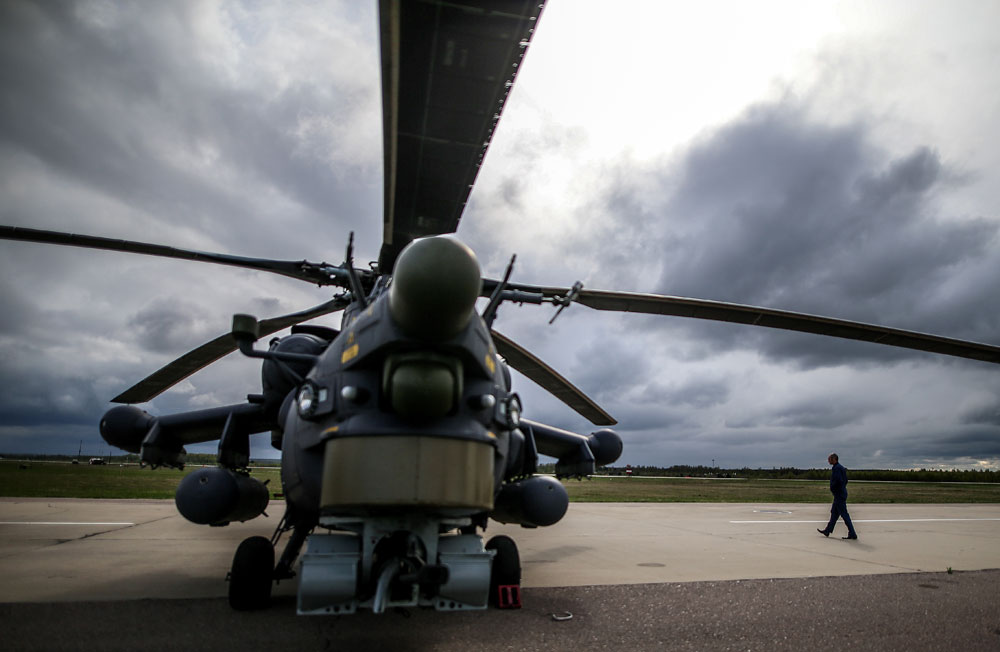
The Mi-28 Night Hunter was in Russian military operation in Syria.
Sergei Bobylev / TASSAt a meeting with military officials and heads of the military-industrial complex on May 10, Russian President Vladimir Putin raised the issue of flaws in the Russian army's operations, which were revealed in the course of the Syrian campaign.
"A very thorough investigation of each of the [flaws] should be carried out, I mean a professional investigation, a most thorough analysis," said Putin.
He did not specify what difficulties were faced by Russian troops during the operation, but later the presidential press secretary Dmitry Peskov provided an interpretation of his words.
"This is, first of all, the operation of certain equipment, the work of certain technical systems," he said.
Russian experts supported Peskov's view that the problems mentioned were mainly of a technical nature. Speaking to RBTH, the chief editor of National Defense magazine Igor Korotchenko suggested that a number of technical flaws were identified in the course of combat testing of the latest Russian weapons.
"Manufacturers were given all the necessary information and tasked to proceed immediately to correct systemic problems in order to avoid these shortcomings in mass production," he said.
Let us recall the equipment that the Russian forces first used in combat in Syria:
• Su-35S fighters;
• The Mi-28 Night Hunter and Ka-52 Alligator combat helicopters;
• Caliber cruise missiles (launched from the Caspian Flotilla's warships and the Rostov-on-Don submarine).
According to TASS military expert Viktor Litovkin, despite the fact that specific types of equipment were not named at the meeting, the generals and representatives of the military-industrial complex in the audience immediately understood to whom and on what issues the president’s words were addressed.
Litovkin also reminded RBTH about the incident with the Su-24 bomber, which was shot down by a Turkish fighter in the air along the Syrian border on Nov. 24, 2015.
"The flights of bombers at the beginning of the operation were conducted in violation of the flight rules – they should be always covered by fighters in the air throughout the combat route," Litovkin said. "This was not done until the tragedy."
According to him, the leadership of the armed forces was also criticized in connection with the crash of the Mi-28N military helicopter in the Homs region on April 12, 2016.
"The tragedy was due to an error of the pilots who operated the flight over difficult and featureless terrain in the dark night conditions," said Litovkin.
"Undoubtedly, this is an exceptional situation. Despite this, the operation command in Syria had to answer to the General Staff for this incident. It was also asked questions about the level of training of the Russian pilots."
Despite these incidents, experts praised the level of organization and conduct of operations in Syria.
"The Russian generals have proved brilliant," said Korotchenko. "This is proved by numerous awards, including Hero of Russia stars on the officers' uniforms."
Putin also talked more about successes than problems at the meeting with the military.
"Since the start of the operation, Aerospace Forces planes have flown more than 10,000 combat missions against international terrorist facilities on the territory of the Syrian Arab Republic, have conducted a large number of strikes on the territory and have engaged over 30,000 targets, including more than 200 facilities for extracting oil and refining oil and crude oil feedstock," he said.
In addition, 115 launches of cruise missiles were performed in the course of the operation, both from the Russian navy's warships and submarines, as well as from strategic bombers and missile carriers.
All rights reserved by Rossiyskaya Gazeta.
Subscribe
to our newsletter!
Get the week's best stories straight to your inbox